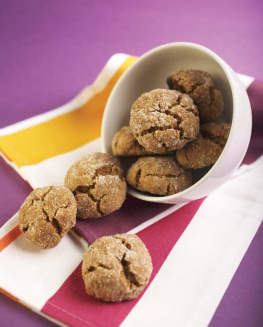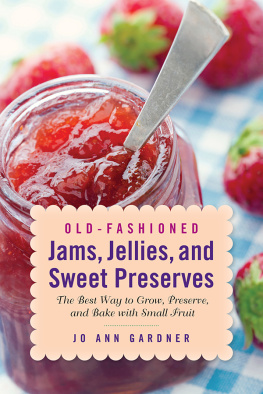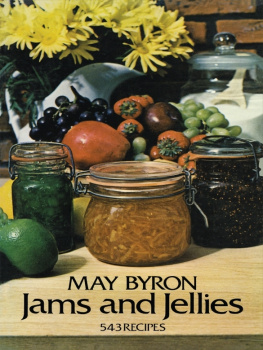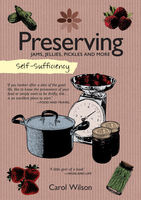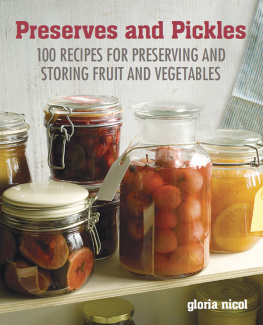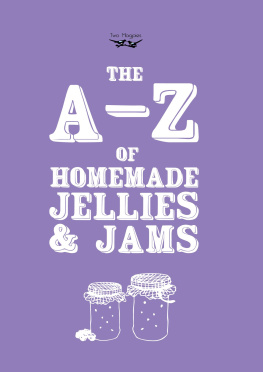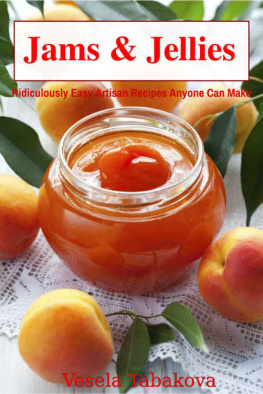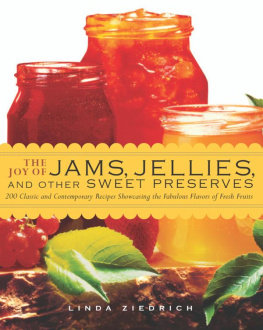All rights reserved. No part of this book may be reproduced by any means whatsoever without written permission from the publisher, except brief portions quoted for purpose of review.
The author and publisher assume no legal or moral responsibility for the outcome or performance of these recipes in your home kitchen, or for the quality or safety of the end product. Many factors present in a home kitchen situation, from the quality and freshness of the fruit to the cleanliness of the utensils and preparation space, can affect the safety of the product.
Introduction
For the cook who loves to serve something deliciously homemade but has little time to spare, Jams and Jellies in Less Than 30 Minutes is the answerfor parties, for holiday meals, and for every day. Youll have the satisfaction that comes from serving homemade jam and jelly without the fuss of canning. People will think you spent hours on a difficult chore when it really wasnt hard at all.
Whether youre new to the kitchen or a veteran cook, you will take genuine delight in creating these small-batch jams and jellies that are not only mouthwatering but beautiful as well. In less than a half hour and in very few steps, you can mix up a sweet treat to savor or to share. A pretty dish of your new kitchen creation can dress up a dinner table. Unused portions can be safely refrigerated for three to four weeks.
Here are methods and recipes for 55 delectable sweet treats that will garner compliments from dinner guests and praise from the family at snack time or mealtime. A small jar of specially made jelly will endear you to any hostess who receives it as a gift, and the delicious, sweet aftertaste of your concoctions will put your name admiringly on the tongues of all your friends who like to talk about food.
These recipes offer creative possibilities as limitless as your imagination. The jams are as delicious in the morning on bagels or croissants as they are served during an elegant brunch or bridal shower. And in many cases they can complement the perfect roast or grilled meat, turn a marinade or sauce from plain to extraordinary, or make an amazing topping for a dish of ice cream.
Tasters have declared that some of these recipes are as decadent as a bowl of chocolate truffles, while others have affirmed the fruity spreads to be as delicious as any delectable candy theyve ever sampled. If your experience with jams and jellies has been limited to basic grape or strawberry, then your jam/jelly world has thus far been colored in terms of gray. When you cook from this book, be prepared for a rainbow of taste explosions! Whether your preference is sweet or savory, familiar or exotic, this collection was made for you. The ingredients youll need are readily available, and each recipe can be simply prepared without intimidation.
Once you get organized, you can make jam or jelly in less than 30 minutes from start to finish! Make one in the morning and serve it that evening to your family, or wow guests at a dinner party or brunch or holiday festivity... the possibilities are endless. With these instructions and recipes as your guide, youre on your way to creating your own memorable signature jams and jellies. Youll be amazed at these little masterpieces in a jar.
A Basic Lesson in Jams & Jellies
Jams and jellies are made from fruits, preserved by sugar, and jelled (thickened). To achieve proper jelling, you must find the right balance of four components: fruit, acid, sugar, and pectin. Pectin is made from apples. It causes the jell to form. All fruits contain some pectinapples, grapes, and plums contain enough natural pectin to form a jell (sometimes called a set) on their own. However, other fruits, like cherries, blackberries, and strawberries, contain very little natural pectin, so they need the addition of pectin that you purchase.
Plain granulated sugar is the sweetener most used in jams and jellies. It is important that you do not reduce the amount of sugar in any of these recipes. You might think that by doing so you will save on caloric intake, or perhaps you think the recipe requires too much sugar for your family. However, a deviation from the amount of sugar called for in the recipe can cause runny jam. Even more important, sugar acts as a preservative; if the correct amount of sugar is not used, yeasts and molds can develop and cause spoilage.
An acid component is also critical to jell formation. With too little acid, your jell will never set. Too much acid can cause the jell to weep, or liquid to separate from the jam around the edges. Lemon juice is the predominant acid used in jelling. Some recipes may call for lime juice, or occasionally vinegar can be used.
Most recipes in this book call for pectin as the jelling agent, although some call for gelatin. I offer some simple guidelines regarding pectin:
Pectin is available in liquid and powder form, 3-1/2-ounce size. Liquid and powdered pectin work equally well but produce slightly different textures of jam. This book suggests liquid and powder for different recipes; my personal preference is for the powdered form. Generally, liquid pectin works better in clear jellies, while powdered pectin works well with jam/jelly that has several fruits. Pectin can be found in the canning supplies section of most grocery stores. While all brands will do the job of thickening your product, they produce slightly different textures. Experiment with different brands to see which you like best.
Pectin has a limited shelf life and packages are stamped with an expiration date. Old pectin might not result in a jell because it loses its potency over time.
Jams and jellies continue to set for up to 24 hours after youve poured them into the jars. So dont fret if it seems too runny at the time of pouring.
Jar Preparation
Follow these easy steps to ensure the jars are sterile:
Place all newly purchased jam/jelly jars in the top rack of your dishwasher. Also include the two-piece lids with bands. Wash on one complete cycle, including a hot cycle. This will sterilize the jars. (Alternatively, you can wash jars in hot soapy water and then pour in boiling water to sterilize them. Be careful not to burn yourself when pouring out the hot water. Drain upside down.)
Allow jars to cool, and handle as little as possible, thus allowing them to remain sterile. Kitchen tongs prove helpful but are not required.
When making cooked jams, place the empty jar(s) on a cookie sheet or mat to protect your countertop. Remember to always leave at least 1/4 inch headspace when filling jars to allow for expansion of the jelly when it gets cold.
Screw the two-piece lids and bands onto your jars to keep the product fresh and clean until ready to serve.
Jams and jellies made from recipes in this book must be stored in your refrigerator or freezer (the individual recipe will so indicate). They are not to be stored without proper refrigeration. Because these products are not sealed in their jars through a heat process, they need to be consumed within the time period noted at the bottom of each recipe. Beyond this period, they should not be considered safe for consumption.


